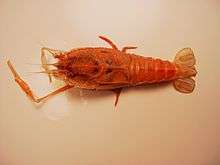Polychelidae
The family Polychelidae contains thirty-eight extant species of blind, benthic lobster-like crustaceans. They are found throughout the world's tropical, sub-tropical and temperate oceans, including the Mediterranean Sea and the Irish Sea.[1][2]
| Polychelidae | |
|---|---|
 | |
| Polycheles sculptus | |
| Scientific classification | |
| Kingdom: | |
| Phylum: | |
| Subphylum: | |
| Class: | |
| Order: | |
| Infraorder: | |
| Family: | Polychelidae Wood-Mason, 1874 |
| Genera and Species | |
Anatomy
The family Polychelidae is notable for the number of chelate (clawed) limbs, with either four or all five pairs of pereiopods bearing claws. This gives rise to the scientific names Polycheles (many-clawed) and Pentacheles (five claws). The first pair of periopods are greatly elongated, but often become broken off while specimens are being brought to the surface. The rostrum is very short or absent, and, although eyestalks are present, the eyes are absent. This family can be seen as evidence of the transition from shrimp-like animals to lobster-like animals, since they possess a number of primitive characters (plesiomorphies), such as the pointed telson, in contrast to the rounded telson in lobsters.
Discovery
Although apparently widespread, and at least locally common, they were first discovered only in the late nineteenth century when they were dredged up by the Challenger expedition from a depth supposed to be "barren, if not of all life, certainly of animals so high in the scale of existence" (Charles Spence Bate). Their kinship with the fossil group Eryonoidea, including well-known genera such as Eryon, was immediately recognised. Since Eryon and its relatives were only known from fossils, lastly in the Jurassic, this made the Polychelidae something of a living fossil.
The reason that polychelids remained unknown for so long is that they live on the sea-floor, often at great depths; the family as a whole has a depth range from less than 100 metres (330 ft) to over 5,000 metres (16,000 ft). This also accounts for the lack of eyesight, since almost none of the sun's light penetrates to such abyssal depths.
Fossil record
A single fossil species is known, Antarcticheles antarcticus, which was found in Jurassic sediments on James Ross Island, close to the Prince Gustav Channel.[3]
Larvae
The larvae of polychelids are very distinctive, and were first described under the name Eryoneicus. Over forty different larval forms are known, although few can be ascribed to known adult species.
Classification
|
|
References
- Bella S. Galil (2000). "Crustacea Decapoda: Review of the genera and species of the family Polychelidae Wood-Mason, 1874". In A. Crosnier (ed.). Résultats des Campagnes MUSORSTOM, Volume 21 (PDF). Mémoires du Muséum national d'Histoire naturelle, 184. Paris: Muséum national d'Histoire naturelle. pp. 285–387. ISBN 2-85653-526-7.
- S. T. Ahyong & D. E. Brown (2002). "New species and new records of Polychelidae from Australia (Crustacea: Decapoda)" (PDF). Raffles Bulletin of Zoology. 50 (1): 53–79. Archived from the original (PDF) on 2012-02-20. Retrieved 2010-01-15.
- M. B. Aguirre-Urreta; L. A. Buatois; G. C. B. Chernoglasov; F. A. Medina (1990). "First Polychelidae (Crustacea, Palinura) from the Jurassic of Antarctica". Antarctic Science. 2 (2): 157–162. doi:10.1017/S0954102090000207.